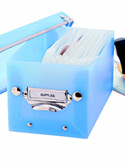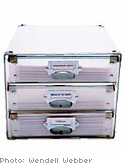
Are your bill-paying methods flustered, scattershot or on the run? Julie Morgenstern helps you sort out your checks and balances.
Bill paying is not for the fainthearted. Whether you view it with dread because all the paperwork feels overwhelming or because you're not sure you have enough money in the bank, you wouldn't be alone in slipping up. Regardless of income, honest people have been known to come home to no lights—or to destroy their credit ratings—because they can't keep track of dates and account balances. Try explaining that to the electric company!
You'll never get to the end of the paperwork—like pirates attacking your ship from all directions, the bills will just keep coming. But with a consistent defense, you can not only stay afloat, but also take control.
Try these three simple rules to get your finances in check for good!
Bill paying is not for the fainthearted. Whether you view it with dread because all the paperwork feels overwhelming or because you're not sure you have enough money in the bank, you wouldn't be alone in slipping up. Regardless of income, honest people have been known to come home to no lights—or to destroy their credit ratings—because they can't keep track of dates and account balances. Try explaining that to the electric company!
You'll never get to the end of the paperwork—like pirates attacking your ship from all directions, the bills will just keep coming. But with a consistent defense, you can not only stay afloat, but also take control.
Try these three simple rules to get your finances in check for good!

Setting up a system to get your bills in order can be as easy as 1-2-3!
Step One
Get it together. Stockpiling bills in the entryway of your house, writing checks at the kitchen table, and filing records in the basement will lead to chaos. Make life easier by creating one convenient bill-paying station, complete with everything you need to get the job done. Designate one basket or drawer for unpaid bills; a nearby spot for envelopes, stamps and pens; and an attractive filing cabinet or portable file box for bank statements and paid bills. If you pay electronically, store your files next to your computer, and keep your passwords and security codes accessible but safe.
Step Two
Become a creature of habit. Decide how frequently you'll deal with bills based on your tolerance for the task and on your cash flow. For some people, ten minutes of writing checks as bills come in removes the anxiety of missing due dates and beats toiling for several hours at a time. A nice compromise is paying bills twice a month—on the 10th and the 25th. If you choose this option, open bills as they come in, highlight the due date, and gather them in two baskets or drawers—one for payments due the 1st through the 15th, the other for those due the 16th through the 31st. Note bill-paying days in your appointment book.
Paying electronically has many advantages: speed, access to real-time balances and the ability to schedule automatic withdrawals for recurring bills. But combining electronic and manual systems is confusing—so choose one or the other.
Step Three
Keep accurate records. Sloppy filing systems make it hard to know whether a bill has been paid, often resulting in duplicate payments or late charges. Mark each bill as paid (along with the check number and date, so you'll have the info ready if you need to call about a mix-up), and file immediately by category.
Religiously record every check you write. Place credit card receipts and deposit and withdrawal slips in folders until the statements come, then reconcile and toss. (It's easy to lose track of ATM withdrawals—make sure you note yours.)
What to Keep, and For How Long
I recommend holding on to utility and phone bills for a year, which will let you see if there's a spike in rates. Bank statements, W-2 forms and receipts for tax-deductible expenses should be on file for seven years, in case you're audited. (If you've got extremely complicated transactions, check with your accountant about keeping records even longer.) Keep bills for appliances and repairs indefinitely—when the time comes for a replacement or another repair, you'll know what you paid last time. You should also retain records of expensive purchases, such as antiques or artwork, in case they're ever stolen or you want to sell them.
Step One
Get it together. Stockpiling bills in the entryway of your house, writing checks at the kitchen table, and filing records in the basement will lead to chaos. Make life easier by creating one convenient bill-paying station, complete with everything you need to get the job done. Designate one basket or drawer for unpaid bills; a nearby spot for envelopes, stamps and pens; and an attractive filing cabinet or portable file box for bank statements and paid bills. If you pay electronically, store your files next to your computer, and keep your passwords and security codes accessible but safe.
Step Two
Become a creature of habit. Decide how frequently you'll deal with bills based on your tolerance for the task and on your cash flow. For some people, ten minutes of writing checks as bills come in removes the anxiety of missing due dates and beats toiling for several hours at a time. A nice compromise is paying bills twice a month—on the 10th and the 25th. If you choose this option, open bills as they come in, highlight the due date, and gather them in two baskets or drawers—one for payments due the 1st through the 15th, the other for those due the 16th through the 31st. Note bill-paying days in your appointment book.
Paying electronically has many advantages: speed, access to real-time balances and the ability to schedule automatic withdrawals for recurring bills. But combining electronic and manual systems is confusing—so choose one or the other.
Step Three
Keep accurate records. Sloppy filing systems make it hard to know whether a bill has been paid, often resulting in duplicate payments or late charges. Mark each bill as paid (along with the check number and date, so you'll have the info ready if you need to call about a mix-up), and file immediately by category.
Religiously record every check you write. Place credit card receipts and deposit and withdrawal slips in folders until the statements come, then reconcile and toss. (It's easy to lose track of ATM withdrawals—make sure you note yours.)
What to Keep, and For How Long
I recommend holding on to utility and phone bills for a year, which will let you see if there's a spike in rates. Bank statements, W-2 forms and receipts for tax-deductible expenses should be on file for seven years, in case you're audited. (If you've got extremely complicated transactions, check with your accountant about keeping records even longer.) Keep bills for appliances and repairs indefinitely—when the time comes for a replacement or another repair, you'll know what you paid last time. You should also retain records of expensive purchases, such as antiques or artwork, in case they're ever stolen or you want to sell them.




